An online project under the direction of the CAPE ANN MUSEUM
inv. 50
Fishing Party
1850 Oil on canvas 19 5/8 x 30 1/4 in. (49.8 x 76.8 cm) Signed and dated lower right: F H Lane 1850.
|
Related Work in the Catalog
Explore catalog entries by keywords view all keywords »
Historical Materials
Below is historical information related to the Lane work above. To see complete information on a subject on the Historical Materials page, click on the subject name (in bold and underlined).
Newspaper
"...It was my good fortune, in the company of a few friends, to visit Mr. Lane's studio where are several fine paintings. Among these were a night scene, with the full moon shining upon the dark tranquil waters with a fire in the distance, which uniting with the soft rays of the moon gave it a most delightful effect. Also a view of Boston with its magnificent harbor, on which are many fine vessels, steamboats, &c. The picture represents a beautiful, calm day, with many fine craft all ready for sea, with their graceful shadows reflected so life-like in the waters, that one feels he too is standing on board, will soon be moving on that expanse which Mr. Lane has made so delightfully placid, that even the greatest coward would be allured into a sea voyage.
I suppose it is generally known that Mr. Lane stands highest– as a marine artist– in the world. Salmon by many was considered his superior, while others gave Lane the precedence. Salmon has passed away with the last year, leaving his immortal gifts and laurels to Europe, while Mr. Lane still lives to bring down the glorious clouds, and make the mighty ocean subservient to his tastes.–
May he long live to gladden the world with his precious gifts, and enjoy his delightful home which refined tastes are beautifying.
His residence commands one of the finest water prospects in town. Standing upon the threshold of his delightful home, we witnessed one of those glorious sunsets which can only be seen in our New England Springs, and as we looked abroad, my friend remarked,"truly, Mr. L. has made the waste places glad." –LOUISE.
[The view in Boston Harbor of which our fair correspondent speaks has been placed on exhibition for a few days in the Reading Room of the Marine Insurance Company. It is a rare specimen of excellence in naval painting. There is a type of almost all the various classes of vessels composing our marine, and so truthfully rendered as to defy criticism. –Ed.Tel]
Brooksville is on the point of land located just across the harbor from Castine, and islands, such as Ram Island (located between Castine and Cape Rosier) would have been easily accessible by boat from Castine.
Indian Bar, on Cape Rosier, was one the routes of the Wabenaki Indians from the Penobscot River to Mount Desert, Deer Isle, or the islands of Penobscot Bay. The Indian Bar provided a short portage into Smith Cove, crossing Cape Rosier to Horseshoe Cove, and from thence to Eggemoggin Reach, from whence one could follow one route to Benjamin River and Salt Pond to Bluehill Harbor, another to Naskeag and Mount Desert, a third to Deer Isle and the outer islands of Penobscot Bay, and a fourth from Billings Cove and Walkers Pond to the Bagaduce River. Coming full circle, one crossed from the Bagaduce to Hatch's or Poverty Cove, above Castine village, to Wadsworth's Cove, and from thence north along the Penobscot. Wadsworth's Cove was the beginning or ending of the Minnewo'kun, "the many directions route."
There isn't much history to relate about Ram Island, other than, as its name suggests, it was used as a sheep pasture, perhaps in connection with the farm at Holbrook Island. Holbrook, or Smart's Island, was occupied prior to the Revolution, and was purchased by Smart's brother-in-law, John Bakeman, and was thus known as Bakeman's Island in 1779. John Bakeman, a shipbuilder and sawmill owner at Goose Falls, Cape Rosier, sold the island to Capt. Jesse Holbrook for £150 in 1783. Capt. Jesse Holbrook died on the island on September 20, 1791 and is buried there with some of his children.
Capt. Jonathan Holbrook, Capt. Jesse's son, sold the island to Capt. Elisha Dyer of Castine in 1801 and removed his family to Northport. The extended Holbrook family would include shipbuilders at Penobscot, Castine, and Islesboro, a fraternity of shipwrights and a pattern of craftsmanship that would define shipbuilding in Hancock County in the nineteenth century. Capt. Holbrook lost his schooner "President," built at Islesboro by his brother-in-law Mighill Parker 1796, to French privateers in the West Indies in 1797, and the schooner "Active" to French privateers, who were interned captured by English privateers in 1800. Benjamin Hook Senior and Abraham Moor, farmers, were living together in an extended household, in 1850, on Holbrook Island, which included Robert Bowden, a mariner. Moor, according to oral history, was expelled from Yale, and spent the remainder of his life as a local eccentric. The Neymans, who also lived on the island, are alleged to be the children of Hook's inamorata Mrs. Ryder.
– Mark Honey
References:
Fannie Hardy Eckstorm, "Indian Place-Names of the Penobscot Valley and the Maine Coast," University of Maine Studies, 2nd Series, #55, November 1941, reprinted 1960 by the University of Maine Press. DeLorme's Atlas, Frank G Speck's "Penobscot Man," University Of Pennsylvania Press, 1940, and Eckstorm, among others, provide useful information on Minnewo'kun.
Mark E. Honey, "Before the Mast," vol. IV, articles 7–9, Holbrook Island and the Holbrook family, and in particular, Robert Applebee, "Vessels of the Penobscot Customs District," Stephan Phillips Memorial Library, Penobscot Marine Museum, Searsport, which source also has the diaries of Capt. Jonathan Holbrook and the genealogy of the Holbrook family in the Priscilla Jones collection. The "Before the Mass" series can be found in the collections of the Castine Historical Society and the Wilson Museum, both in Castine.
Charles B. McLane, and Carol Evarts McLane, "Islands of the Mid-Maine Coast," Penobscot Bay, vol. 1, rev. ed., (Gardiner, ME: Tilbury House; in association with the Island Institute, Rockland, ME, 1982).
Harald E. L. Prins, and Bunny McBride, "Asticou's Island Domain: Wabenaki Peoples at Mount Desert Island," 1500–2000, Acadia National Park, Ethnographic Overview and Assessment, vol. 1, repaired under cooperative agreement with The Abbe Museum, Bar Harbor, Maine, Northeast Regional Ethnography Program, National Park Service, Boston, Massachusetts, September, 2007.
The colonial American shallop is the ancestor of many regional types of New England fishing craft found in Lane's paintings and drawings, including "New England Boats" (known as "boats"), and later descendents, such as "Chebacco Boats," "Dogbodies," and "Pinkies." (discussed elsewhere)
These boats were very common work boat types on Cape Ann throughout the 1800s. They were primarily used for inshore coastal fishing, which included lobstering, gill-netting, fish-trapping, hand-lining, and the like. They were usually sailed by one or two men, sometimes with a boy, and could be rowed as well as sailed. An ordinary catch would include rock cod, flounder, fluke, dabs, or other small flat fish. The catch would be eaten fresh, or salted and stored for later consumption, or used as bait fish. Gill-netting would catch herring and alewives when spawning. Wooden lobster traps were marked with buoys much as they are today, and hauled over the low sides of the boat, emptied of lobsters and any by-catch, re-baited and thrown back.
THE SHALLOP
Like other colonial vessel types, shallops were defined in many ways, including size, construction, and rig. Most commonly, they were open boats with square or sharp sterns, 20 to 30 feet in length, two-masted rigs, and heavy sawnframe construction which in time became lighter. (1)
The smaller shallops developed into a type called the Hampton Boat early in the nineteenth century, becoming the earliest named regional variant of what is now collectively termed the New England Boat. Other variants were named for their regions of origin: Isles of Shoals Boat, Casco Bay Boat, No Mans Land Boat, to name a few. No regional name for a Cape Ann version has survived, and "boat," or "two-masted boat" seems to have sufficed. (2)
Gloucester's New England Boats were mostly double-enders (sharp sterns) ranging in length from 25 to 30 feet, with two masts and two sails (no bowsprit or jib). They were used in the shore fisheries: handlining, gillnetting, and gathering or trapping shellfish (see View from Kettle Cove, Manchester-by-the-Sea, 1847 (inv. 94), View of Gloucester Harbor, 1848 (inv. 97), and /entry: 240/). (3)
Larger, double-ended shallops became decked and evolved in Ipswich (the part now called Essex) to become Chebacco Boats. (4) This variant retained the two-mast, two-sail rig, but evolved further, acquiring a bowsprit and jib and becoming known as a pinky (see Gloucester Harbor from Rocky Neck, 1844 (inv. 14), The Western Shore with Norman's Woe, 1862 (inv. 18), and The Old Fort and Ten Pound Island, Gloucester, 1850s (inv. 30)). The Chebacco Boat became a distinct type by the mid-eighteenth century giving rise to the pinky in the early ninetennth century; the latter, by the early 1900s. (5)
References:
1. William A. Baker, Sloops & Shallops (Barre, MA: Barre Publishing Co., 1966), 27–33; and “Vessel Types of Colonial Massachusetts,” in Seafaring in Colonial Massachusetts (Boston: The Colonial Society of Massachusetts, 1980), 13–15, see figs. 10, 11.
2. Howard I. Chapelle, American Small Sailing Craft (New York: W.W. Norton & Co., 1951), 136–45.
3. Ibid., 145, upper photo, fourth page of plates.
4. Baker, 82–91.
5. Chapelle, The American Fishing Schooners, 1825–1935 (New York: W.W. Norton & Co., 1973), 23–54.
THE NEW ENGLAND BOAT
By the 1840s, the Gloucester version of the New England Boat had evolved into a distinct regional type. Referred to locally as “boats,” the most common version was a double-ender, i.e. having a pointed stern, unlike the less common version having a square stern.
Both variants had two masts, a foresail, a mainsail, but no bowsprit or jib. Lane depicted both in several paintings, beginning in the mid-1840s (see View from Kettle Cove, Manchester-by-the-Sea, 1847 (inv. 94), View of Gloucester Harbor, 1848 (inv. 97), and /entry: 240/), all ranging 25 to 30 feet in length. In View of Gloucester Harbor, 1848 (inv. 97) and Gloucester Inner Harbor, 1850 (inv. 240), a double-ender can be seen on the beach while a square-stern version lies at anchor in the harbor, just to the right of the former. (1)
Lane’s depictions of the double-enders show lapstrake hull planking in View of Gloucester Harbor, 1848 (inv. 97) and Gloucester Inner Harbor, 1850 (inv. 240), and cuddies (short decking) inboard at the ends for shelter and stowage of fishing gear in View from Kettle Cove, Manchester-by-the-Sea, 1847 (inv. 94). The few square-stern examples (see View of Gloucester Harbor, 1848 (inv. 97) and Gloucester Inner Harbor, 1850 (inv. 240)) suggest carvel (smooth) planking and paint finish, rather than oil and tar. The presence of an example of the latter variant in Boston Harbor, as noted in Boston Harbor, c.1850 (inv. 48), suggests a broader geographical range for this subtype. (2)
The primary use of Cape Ann’s “boats” was fishing, making “day trips” to coastal grounds for cod, herring, mackerel, hake, flounder, and lobster, depending on the season. Fishing gear included hooks and lines, gill nets, and various traps made of wood and fish net.
Some boats worked out of Gloucester Harbor, but other communities on Cape Ann had larger fleets, such as Sandy Bay, Pigeon Cove, Folly Cove, Lanesville, Bay View, and Annisquam. Lane’s depictions of these places and their boats are rare to nonexistent. (3)
The double-ended boat served Lane in marking the passage of time in Gloucester Harbor. In View from Kettle Cove, Manchester-by-the-Sea, 1847 (inv. 94), we see new boats setting out to fish, but in View of Gloucester Harbor, 1848 (inv. 97) and Gloucester Inner Harbor, 1850 (inv. 240), a boat of the same type is depicted in a progressively worn state. In Stage Fort across Gloucester Harbor, 1862 (inv. 237), the boat is a stove hulk on a beach, and in the same year, Lane depicted the type’s shattered bottom frame and planking lying on the shore at Norman’s Woe in Norman's Woe, Gloucester Harbor, 1862 (inv. 1).
Regional variants of the New England Boat appear in Lane’s paintings of Maine harbors, including one and two-masted versions, collectively called Hampton Boats (see Bear Island, Northeast Harbor, 1855 (inv. 24), Ten Pound Island at Sunset, 1851 (inv. 25), Fishing Party, 1850 (inv. 50), Father's (Steven's) Old Boat, 1851 (inv. 190), and "General Gates" at Anchor off Our Encampment at Bar Island in Somes Sound, Mount Desert, Maine, 1850 (inv. 192)). Some distinctive regional types were given names, i.e. Casco Bay Boats ("General Gates" at Anchor off Our Encampment at Bar Island in Somes Sound, Mount Desert, Maine, 1850 (inv. 192) may be one), but many local type names, if they were coined, have been lost. (4)
References:
1. Howard I. Chapelle, American Small Sailing Craft (New York: W.W. Norton & Co., 1951), 141–42.
2. Ibid., 152–55.
3. Sylvanus Smith, Fisheries of Cape Ann (Gloucester, MA: Press of the Gloucester Times, 1915), 96–97, 102–05, 110–13.
4. Chapelle, 152–55.
Also filed under: Ship Models »
Also filed under: Ship Models »
The term “wherry”—variously spelled—has a long history with many hull types, some dating from the fifteenth century. (1) The version known to Lane appears to be a variant of the dory hull form and probably was developed by French and English fishermen in the Newfoundland fisheries before 1700. (2) From that time, the wherry and the dory co-evolved, their similarities the result of their construction, their differences the result of use. By the early nineteenth century, their forms reached their final states, if fragments of contemporary descriptions are any indication. (3)
By the time Lane was depicting wherries, the type (as used for fishing) resembled a larger, wider version of a dory. The extra width was due to greater bottom width (both types had flat bottoms), with a wider transom at the stern instead of the narrow, v-shaped “tombstone.” These features are easy to see in one of his drawings (see Three Men, One in a Wherry (inv. 225)) and a painting (see Sunrise through Mist, 1852 (inv. 98)), the latter depicted alongside a dory, clearly showing the differences.
No published descriptions of the uses of wherries on Cape Ann in Lane’s time have come to light, but an example in broadside view offers one use. In Becalmed Off Halfway Rock, 1860 (inv. 344), a pinky (in right foreground) has a dory and a wherry in tow, the latter loaded with a gill net for catching mackerel. (4) The greater size of the wherry is required for stowing the net, as well as setting it while the dory tows away one end to set it in way of the mackerel school.
In Lane’s time, wherries would have been used where bulky gear was called for in the coastal fisheries, i.e. gill nets, and fish traps such as pound nets, fyke nets, and lobster traps. Migrating fish schools (herring, mackerel) and shellfish were the target species.
The dory’s development was first dictated by its use in shore fishing, where small size and light weight made it easy to maneuver around rocks and shallows, and to haul ashore at the end of a day’s work. Its simple design made it easy and cheap to build. This is borne out by the standardized construction and sizes used by Simon Lowell’s boat shop at Salisbury Point, Massachusetts at the turn of the nineteenth century. Lowell called his boats “wherries,” but in Swampscott, Massachusetts, the fishermen, who used them called them “dories,” which may mark the beginning of the latter term’s wider use. (5)
The dories we see in Lane’s paintings are in virtually every way like the ones we know today. One of the best examples (see View from Kettle Cove, Manchester-by-the-Sea, 1847 (inv. 94)) even shows interior detail, including frames, leaving no doubt about its construction. Other good examples are found in Salem Harbor, 1853 (inv. 53), View of Gloucester Harbor, 1848 (inv. 97), and Sunrise through Mist, 1852 (inv. 98).
For inshore fishing, dories were used to catch mackerel and herring, either with hook and line or with small nets. Hooks and line were used for flat fish (flounder, dab, and fluke), rock cod, hake, and cunner. Eels were speared (see View from Kettle Cove, Manchester-by-the-Sea, 1847 (inv. 94)), clams were dug, and lobsters trapped. In Lane’s later years, the use of dories in trawling (setting long “trawl lines” with many baited hooks) was in its earliest. This method required six to ten dories carried on board a schooner to fish on the distant banks off New England and Canada. Early records of dory trawling in New England are fragmentary, giving the mid-1840s as the time of introduction. (6) The Gloucester-owned schooner "Anna" made a successful dory trawling trip to the Grand Banks in 1854, but no depiction of this vessel by Lane has been found or recorded. (5) Despite successful early efforts, dory trawling from Gloucester was slow to be accepted, and the fishery had very limited growth prior to 1860. (7)
– Erik Ronnberg
References:
1. M.H. Parry et al., Aak to Zumbra (Newport News, VA: The Mariners’ Museum, 2000), 634.
2. John Gardner, The Dory Book (Camden, ME: International Marine Publishing Company, 1978), 5–9.
3. Ibid., 25–29.
4. John Wilmerding, ed., Paintings by Fitz Hugh Lane (Washington, DC: National Gallery of Art, 1988), 89, 92. The “possibly discarded whaleboat” is definitely a wherry.
5. Gardner, 9, 10.
6. Wesley George Pierce, Goin’ Fishin’ (Salem, MA: Marine Research Society, 1934), 63–64.
7. Raymond McFarland, A History of New England Fisheries (Philadelphia: University of Pennsylvania, 1911), 279.
Stereograph card
Procter Brothers, Publisher
Cape Ann Museum Library & Archive
"Gloucester Harbor from Rocky Neck, Looking Southwest. This gives a portion of the Harbor lying between Ten Pound Island and Eastern Point. At the time of taking this picture the wind was from the northeast, and a large fleet of fishing and other vessels were in the harbor. In the range of the picture about one hundred vessels were at anchor. In the small Cove in the foreground quite a number of dories are moored. Eastern Point appears on the left in the background."
Southeast Harbor was known for being a safe harbor.
Also filed under: Gloucester Harbor, Outer » // Historic Photographs » // Rocky Neck » // Schooner (Fishing) »
Also filed under: Chebacco Boat / Dogbody / Pinky » // Ship Models »
Gloucester, MA
4 x 33 1/2 x 7 1/4 in (10.16 x 85.09 x 18.415 cm)
Peabody Essex Museum
Also filed under: Objects » // Ship Models »
"Hand-lining" was fishing with a single line which had one or sometimes two hooks, as opposed to "trawling," in which a single line had many hooks. Hand-lining was the exclusive American fishing method from colonial times to the mid-19th century, and continued in use, taking second place to dory trawling only after the Civil War. Even then, it persisted into the twentieth century for some offshore fishing grounds, while hand-lining from dories remained a favored method for the shore fisheries.
Hand-line fishing on the offshore banks was done in relatively shallow water (10 to 45 fathoms), often over rocky bottom. This method depended on catching fish at mid-levels as well as on the bottom, hence the lines were relatively short, seldom longer than 75 fathoms. Each fisherman worked two lines, fishing from the schooner's rail. Bait could be salted clams, fresh-caught squid, and even birds.
Hand-lining by American schooners on the Grand Banks declined in the 1830s as they turned to Georges Bank to exploit that neglected resource. In doing so, they turned to a highly modified hand-lining gear using two hooks on a single line. The hooks were on a pair of long gangings (leaders), joined at the sinker and spread apart 12 to 18 inches by a metal rod (or wooden spreader) called a "sling ding." The hand-line itself was much longer - as much as 900 feet, allowing the gear to cover a broad area over a shallow sandy bottom with few obstructions.
On Georges Bank, the schooners anchored where the wind would set the vessels broadside to tidal currents, with the crew fishing from the down-current side. This allowed the lines to be paid out without getting tangled with each other or bunching up astern. The long hand-lines, combined with heavy sinkers and (hopefully) two large cod on the hooks made for strenuous hauling, made all the more so by the tidal current. Georges fishermen were regarded as the strongest in the Cape Ann fisheries.
The wealth of resources and the proximity of Georges Bank was offset by its hazards in heavy weather, as many of Gloucester's widows could testify. Breaking shallows, mountainous waves and winter storms took their toll, but this danger was compounded when numerous vessels anchored within sight of each other. A parted anchor cable could send a vessel crashing into another with the loss of both with their crews.
Steel engraving after drawing in G. Brown Goode, The Fisheries and Fishery Industries of the United States (Washington, DC: Government Printing Office)
8 1/2 x 11 in. (page size)
Cape Ann Museum Library & Archive, Gloucester, Mass.
See pl. 31.
Shows the two basic types of hand-line gear in use in mid-ninteenth century. At left is the Georges gear, developed for fishing on Georges Bank. At right is shoal water gear, as commonly used in the inshore fisheries using dories and other small craft. The spreader, or "sling-ding" was used on this type of gear with the advent of dory hand-lining on offshore grounds.
Also filed under: Cod / Cod Fishing »
Steel engraving after drawing in G. Brown Goode, The Fisheries and Fishery Industries of the United States (Washington, DC: Government Printing Office, 1883)
8 1/2 x 11 in. (page size)
Cape Ann Museum Library & Archive, Gloucester, Mass.
See pl. 32.
Also filed under: Cod / Cod Fishing » // Georges Bank, Mass. »
Model made for marine artist Thomas M. Hoyne
scale: 3/8" = 1'
Thomas M. Hoyne Collection, Mystic Seaport, Conn.
While this model was built to represent a typical Marblehead fishing schooner of the early nineteenth century, it has the basic characteristics of other banks fishing schooners of that region and period: a sharper bow below the waterline and a generally more sea-kindly hull form, a high quarter deck, and a yawl-boat on stern davits.
The simple schooner rig could be fitted with a fore topmast and square topsail for making winter trading voyages to the West Indies. The yawl boat was often put ashore and a "moses boat" shipped on the stern davits for bringing barrels of rum and molasses from a beach to the schooner.
– Erik Ronnberg
References:
Jeffrey Bolster, Black Jacks: African American Seafarers in the Age of Sail (Cambridge, MA: Harvard University Press, 1997).
Howard I. Chapelle, American Small Sailing Craft (New York: W.W. Norton & Co., 1951), 29–31.
Also filed under: Schooner (Fishing) » // Ship Models »
The construction of the Gloucester branch of the Eastern Railroad from Salem in 1848 transformed Cape Ann from a sleepy rural area to a bustling metropolis, with summer visitors from Boston and New York arriving daily. The development of the tourist industry was part of a more general growth of tourism up and down the east coast of the United States. Seacoast and mountain areas were served first by stage coaches and then by railroads bringing urban visitors during the summers. Cape Ann was also a day trip for summer residents of places like Beverly and Manchester.
The railroad journey from Boston was not a difficult one. An advertisement listed in the Boston Directory of 1848 reported that there were eleven trains a day for Portsmouth and Salem. It also noted the: "Advantages of a Residence on this Route. No Railroad affords access to so many, so varied, and so splendid sea-side locations, or passes through so many pleasant cities, towns, and vlllages. Its Depots are within a mile or two of the celebrated beaches of Chelsea, Nahant, Swampscot, and Marblehead. A Branch [railroad] skirts the shores of Massachusetts Bay, in the towns of Beverly, Manchester, and Gloucester, opening most magnificent views of the ocean, leading to most retired spots for sea-bathing, and to the most delightful walks and drives in the native forests, that can be found in New England. This shore is rapidly filling up with marine villas and cottages."
By the 1850s Gloucester had three full-size hotels, the Pavilion, the Union House, and the Gloucester House, as well as a number of summer residents, such as Charles Hovey.
Newspaper
"Among the many visitors of the Cape at this delightful season is Champney, the artist, who has been sketching among our quiet coves and breezy headlands."
Also filed under: Champney, Benjamin » // Newspaper / Journal Articles »

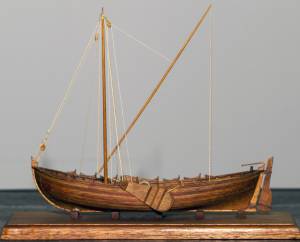
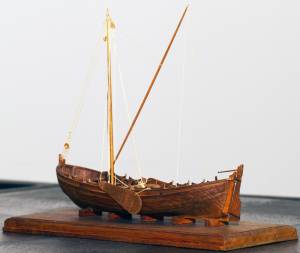
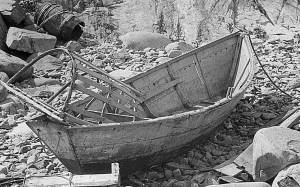


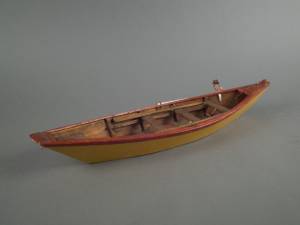
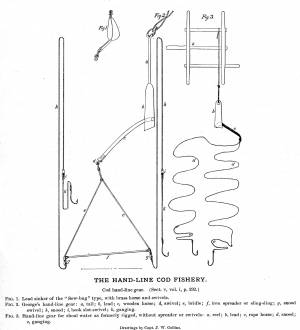
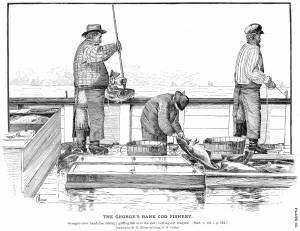
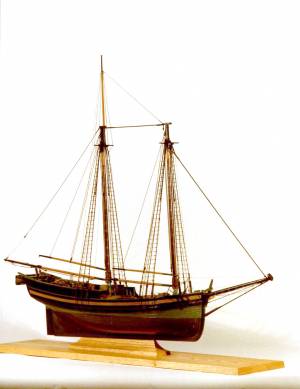
Commentary
This wonderful moonlit scene shows the continuation of the afternoon picnic on Indian Bar Cove shown in View of Indian Bar Cove, Brooksville, Maine, 1850 (inv. 61). Lane has shown the scene from the same location, seemingly from the water just behind the boat, but it is now a few hours later and a magnificent full moon has risen and illuminated the night sky. A few people are back in the boat, and a boy has caught a fish off the side while a man in a dinghy poles out from the shore. On shore, a couple strolls arm in arm in the moon path while three ladies in their bonnets sit together above the beach. Three men stoke a roaring fire under the embankment by the water, the light flickering in the rising smoke. The location is on the tidal Bagaduce River near Castine, the home of Lane’s good friends the Stevenses, and where he was a frequent visitor during summers he spent in Maine.
This is an unusually sentimental and even romantic scene for Lane, whose work usually has a certain formality and rigor. He rarely painted people at their leisure or in social settings. There are many calm and contemplative moments in Lane’s work, particularly in the late work as the compositions simplified and light and space became the dominant subject. However, the tranquility in those paintings is an effect of weather and light; the few people seen are anonymous and going about their business and incidental to the scene. In this work, as in the companion piece, the subject is the picnic and the people attending. In both pictures there are precisely sixteen people shown, however tiny, and one imagines Lane, or his friend Stevens, knew every one of them. This must have been a memorable event for Lane to paint it twice. Perhaps one or both of the pictures were a gift or commission for one of the attendees.
Night and moonlit scenes are very difficult to paint, and Lane only did a few, though he did many twilight paintings. Robert Salmon, the great English painter living in Boston and a major influence on Lane in his early years, did a number of very accomplished moonlit scenes that Lane may have seen that could have influenced this work or provided clues as to technique.
In a contemporary description of what may be this painting, a visitor to Lane’s studio perfectly describes the two contrasting sources of light: "a night scene with the full moon shining upon the dark tranquil waters—with a fire in the distance, which uniting with the soft rays of the moon gave it a most delightful effect."
– Sam Holdsworth
[+] See More